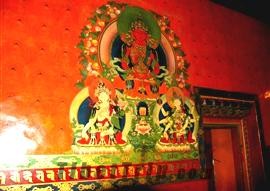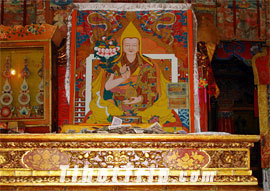Information about mysterious Tibetan Buddhism figures.
Statues,
murals and
Thangkas are common sights in the temples of Tibet. While their various motifs allude to different religions, most are from Tibetan Buddhism. Religious figures are normally used either for worship by the faithful people or to tell a story.

Buddhas
Sakyamuni, the founder of Buddhism, appears in almost all the monasteries of Tibet. He is said to be a descendant of the royal family of ancient India. His life is shrouded in myth and legend. According to one such legend, he was able to walk just moments after being born. He took seven steps and lotuses sprouted from the ground his feet had touched. Several years later he became a monk and attained enlightenment under a banyan tree. Statues and paintings usually depict Sakyamuni with a round face and long ears down to the shoulder. He has a noble, kind and wise physiognomy. There is a small white dot between his brows. His hair is dextral and bulges into a knot at the top. He usually wears a loose-fitting robe that leaves his chest and right shoulder exposed. A golden aura emanates from his body. His chest, palms, and the undersides of his feet are marked with the Buddhist Swastika (卐). His hands are usually placed in a symbolic position. He is commonly depicted in one of three positions: standing, sitting cross-legged, or lying on his right side.
Other well-known Buddhas, such as Vairocana, Buddha of the central world, Amitabha, the master of the Western Pure Land, Maitreya, the Laughing Buddha, Sangye Menla, the Medicine Buddha, and the Buddha of the Eastern Pure Land, are also common sights in Tibetan temples. These Buddhas look similar, but have slightly different gestures and poses.


Bodhisattvas
A Bodhisattva is a person who is prepared for enlightenment before becoming a Buddha. Figures of Bodhisattvas usually appear in the company of a sitting or meditating Buddha. However, they are sometimes depicted on their own. They can be male or female. The most well-known are Avalokiteshvara, or Goddess of Mercy, and Manjusri, or Bodhisattva of Wisdom.
Avalokiteshvara is the most respected and popular Bodhisattva among the Buddhist community. In China, Avalokiteshvara is generally accepted as being female and is known for her feminine qualities of mercy and generosity. She is usually depicted in the company of Amitabha. Avalokiteshvara is said to have 32 avatars. She may be portrayed with thousands of hands and eyes and many heads. She usually holds an object in hand, the most common being a lotus, a vase or a willow branch.
Manjusri is usually depicted to the left of Sakyamuni. He wears a purple and gold gown and his hair is tied in a knot at the top. He usually rides on a lion and holds a green lotus in his left hand while brandishing a sword in his right.

Guardians of Buddhist Doctrines
These figures usually look angry and fierce in order to frighten devils away. The most common are the Four Heavenly Kings, namely Dhrtarastra, Vaishravana, Virupaksa and Virudhaka. Dhrtarastra is the eastern guardian for protecting the country. He wears white and holds a Chinese lute. Vaishravana is the northern guardian for hearing. He wears green and holds an umbrella. Virupaksa is the western guardian for seeing. He wears red and holds a dragon. Virudhaka is the southern guardian for increasing wisdom. He wears cyan and holds a sword.

The Eighteen Arhats
These are the disciples of Sakyamuni. According to the Buddhist sutras, when Buddha reached Nirvana he asked them to remain on earth permanently to bring good fortune to the people. As a result, images of them often appear in the sculptures and paintings inside Buddhist temples.


Buddhist Masters
Tsong Khapa, called 'Buddha the Second', is another popular figure. He is the founder of Gelugpa, the Yellow Hat Sect of Buddhism. His reforms of Buddhist doctrine forged a more powerful and influential form of the religion. His two disciples became the first Dalai Lama and Panchen Lama, setting in place a complex reincarnation system of succession. Tsong Khapa wore distinctive clothes to differentiate himself from other monks, and in almost all Gelugpa monasteries monks don yellow peach-slice-shaped hats, orange cassocks and maroon robes with decorative patterns on the shoulders in his likeness.
Padmasambhava and Atisha, the ancient ascetics who spread Indian Buddhism to Tibet, are also respected and worshipped by the Tibetans. Padmasambhava was initially an Indian prince before becoming a pious Buddhist monk. Late in the 8
th Century, he brought Esoteric Buddhism to Tibet and preached its virtues until the religion flourished and prospered. The first temple of Tibet,
Samye Monastery was built under his guidance. Atisha, initially a prince of the present day Bengal, had done much work to revive Tibetan Buddhism when the later King Lang Darma (reign 836 - 842) tried to forbid it.

Historical Figures of Tibet
Princess Wencheng is often portrayed in sculptures or paintings and is worshipped by Tibetans as the avatar of Tara. She was originally a princess of the Tang Dynasty (618-907) and later married Songtsen Gampo (617-650), a great king of the then Tubo Kingdom of Tibet. The princess was a devout Buddhist. She brought the statue of the 12-year-old Sakyamuni (now in
Jokhang Temple ), the calendar, medicine and other things from central China into Tibet, and also advised the king to build many palaces and monasteries. These made the kingdom more prosperous, and Buddhism became the dominant religion.
Other Tibetan historical figures, such as Songtsen Gampo, King Trisong Detsen (742-798), Princess Jincheng (another princess of the Tang Dynasty), and Dalai Lamas and Panchen Lamas, also often appear in sculptures or paintings.
END=OM MANI PADME HUM.( 3 TIMES ).RESEARCH BUDDHIST TIBET DHARMA BY GESHE TESERING TASHI .AUSTRALIA.OM MANI PADME HUM.5/2/2012.


No comments:
Post a Comment